


 |
October 23, 1991: A Day in San Juan, Puerto Rico |
 |
October 21, 1991: A Day at Sea on the Costa Riviera |
 |
Return to the Caribbean Cruise Index |
It is Tuesday morning, and we are coming to our first port of call- Charlotte Amalie on the island of St. Thomas, one of the three main islands in the United States Virgin Islands.
The United States Virgin Islands
|
In 1990 the population was about 85,000- mostly Afro-Caribbean, although St. Thomas and St. Croix are beginning to be promoted as a retirment destination. Tourism is the primary economic activity, although there is a significant rum manufacturing sector. Farming is done on a relatively smaller scale on the island of St. Croix, although it has seen a slow revival in recent years.
Previously the Danish West Indies of the Kingdom of Denmark–Norway, they were sold to the United States by Denmark in the Treaty of the Danish West Indies of 1916. They are classified by the UN as a Non-Self-Governing Territory, and are currently an organized, unincorporated United States territory.
The U.S. Virgin Islands are organized under the 1954 Revised Organic Act of the Virgin Islands and have since held two constitutional conventions. To date, an official constitution has not be adopted and ratified by the U.S. Congress- why, I have no idea. It's hard for me to see how you couldn't come up with something workable when all you have is three major islands and a couple of football stadiums full of people. But what do I know?
Arriving at St. Thomas and the Town of Charlotte Amalie
|
The territory consists of three main islands: Saint Thomas, Saint John, and Saint Croix, as well as several dozen smaller islands. The main islands have nicknames often used by locals: "Twin City" (St. Croix), "Rock City" (St. Thomas) and "Love City" (St. John). The combined land area of the islands is roughly twice the size of Washington, D.C.
The U.S. Virgin Islands are known for their white sand beaches, including Magens Bay and Trunk Bay, and strategic harbors, including Charlotte Amalie and Christiansted. Most of the islands, including Saint Thomas, are volcanic in origin and hilly. The highest point is Crown Mountain on Saint Thomas- about 1,500 feet high.
Saint Croix, the largest of the U.S. Virgin Islands, lies to the south and has a flatter terrain. The National Park Service owns more than half of Saint John, nearly all of Hassel Island, and many acres of coral reef. These are protected by Virgin Islands National Park, Virgin Islands Coral Reef National Monument, Buck Island Reef National Monument, Christiansted National Historic Site, and Salt River Bay National Historical Park and Ecological Preserve.
The U.S. Virgin Islands lie on the boundary of the North American plate and the Caribbean Plate. Natural hazards include earthquakes and tropical cyclones (including hurricanes).
|
The U.S Virgin Islands were originally inhabited by the Ciboney, Carib, and Arawaks- all native peoples of the New World. The islands were named by Christopher Columbus on his second voyage in 1493 for Saint Ursula and her virgin followers. Over the next two hundred years, the islands were held by many European powers, including Spain, Great Britain, the Netherlands, France, and Denmark-Norway.
The Danish West India Company settled on Saint Thomas in 1672, settled on Saint John in 1694, and purchased Saint Croix from France in 1733. The islands became royal Danish colonies in 1754, named the Danish West Indian Islands. Sugar cane, produced by slave labor, drove the islands' economy during the 18th and early 19th centuries.
The Danish West India and Guinea Company represented the first Europeans to settle the Virgin Islands. They are also credited with naming the island St. John. The Danish crown took full control of Saint John in 1754 along with St. Thomas and St. Croix. Sugar cane plantations such as the famous Annaberg Sugar Plantation were established in great numbers on St. John because of the intense heat and fertile terrain which provided ideal growing conditions. The establishment of sugar cane plantations also led to the buying of more slaves from Africa. In 1733 St. John was the site of one of the first significant slave rebellions in the New World when a slave group took over the island for six months.
|
The Danish were able to defeat the enslaved Africans with help from the French in Martinique. Instead of allowing themselves to be recaptured more than a dozen of the ringleaders shot themselves before the French forces could capture them and call them to account for their activities during the period of rebel control. It is estimated that by 1775, slaves outnumbered the Danish settlers by a ratio of 5:1. The indigenous Caribs and Arawaks were also used as slave labor to the point of the entire native population being absorbed into the larger groups. Slavery was abolished in the Virgin Islands on July 3, 1848.
For the remainder of the period of Danish rule the islands were not economically viable and significant transfers were made from the Danish state budgets to the authorities in the islands. In 1867 a treaty to sell Saint Thomas and Saint John to the United States was agreed, but the sale was never effected. A number of reforms aimed at reviving the islands' economy were attempted, but none had great success. A second draft treaty to sell the islands to the United States was negotiated in 1902 but was defeated in the upper house of the Danish parliament on a tie vote. The tie vote was cast by a 97-year-old life member was physically carried into the chamber from his hospital bed.
|
While all this was going on, I thought I would finish the history of the U.S. Virgin Islands from the ship newspaper.
The onset of World War I brought the reforms to a close and again left the islands isolated and exposed. During the submarine warfare phases of the First World War, the United States, fearing that the islands might be seized by Germany as a submarine base, again approached Denmark about buying them. After a few months of negotiations, a selling price of $25 million in United States gold coin ($200 million in 1990 and $550 million in 2016) was agreed.
The Treaty of the Danish West Indies was signed in August 1916, and approval via a Danish referendum followed. The deal was finalized on January 17, 1917, when the United States and Denmark exchanged their respective treaty ratifications. The United States took possession of the islands on March 31, 1917 and the territory was renamed the Virgin Islands of the United States. Every year Transfer Day is recognized as a holiday, to commemorate the acquisition of the islands by the United States. U.S. citizenship was granted to the inhabitants of the islands in 1927.
Water Island, a small island to the south of Saint Thomas, was initially administered by the U.S. federal government but is not actually part of the U.S. Virgin Islands territory; negotiations are, apparently, ongoing to add this small island to the territory.
The islands are still recovering from Hurricane Hugo, which hit the islands dead center almost exactly two years ago. Hugo caused catastrophic physical and economic damage. (Note from 2016: If you know anything about typical hurricane paths, you will know that they frequently curve along the north side of the archipelago, Puerto Rico and Cuba, and so both the British Virgin Islands and their U.S. counterpart are right in that path. The U.S. Virgin Islands would be struck by Hurricane Marilyn in 1995, killing eight people and causing more than $2 billion in damage. Other hurricanes hit the islands in subsequent years: Bertha in 1996, Georges in 1998, Lenny in 1999, and Omar in 2008, but damage was not as severe in those storms.)
|
I am told that ships like the Costa Riviera bring with them almost all of what they need, since the island ports can't manufacture or grow the varied supplies that are consumed on board. But there are some items (water, for instance) that can be replenished at any port. Here, the ship was taking on some local fruit and fish. I went back down to the cabin to get cleaned up and go to breakfast with Grant.
The weather this morning seems to be quite good, and since we have an excursion booked that will take us out on a smaller boat, that's a good thing. The United States Virgin Islands enjoy a tropical climate, with little seasonal change throughout the year. Rainfall is concentrated in the high sun period (May thorough October), while in the winter the northeast trade winds prevail. Summer and winter high temperatures differ by 5°F or less on average.
I enjoyed watching the docking procedure, this being the first time I have been on a boat of this size. It was very interesting, and certainly showed off the skills of the harbor pilot.
A Snorkeling Excursion off St. Thomas
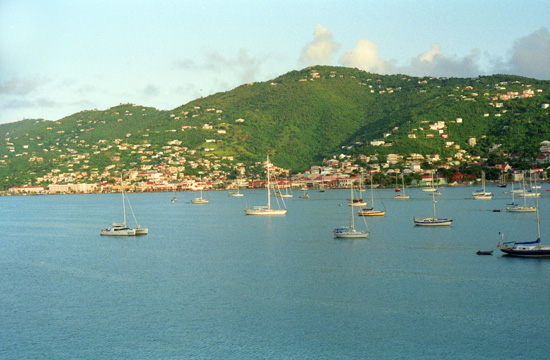 The Harbor at Charlotte Amalie, St. Thomas, USVI |
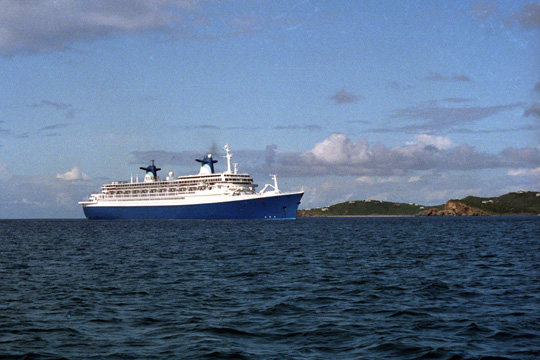 The S.S. Norway Coming In to Anchor off Hassel Island |
As you can see from the pictures above, it is a beautiful day here in the islands, and we are very much looking forward to the excursion. Grant thought that the harbor here was just amazing, what with all the sailboats and other craft moored all around us.
|
Here, and in the picture above, left, you can see a number of sailboats moored at their mid-harbor anchorage, and you can see the town of Charlotte Amalie in the background. I happened to know from my previous travels that there were two Baskin-Robbins stores here on St. Thomas, and I resolved to go in search of both of them later that day before the ship sailed. The day was becoming quite warm, but with gentle breezes constantly blowing. Most of these sailboats, Grant said, were thirty-five to forty feet long, longer than the S2.
While Grant went back to the cabin to get some things he would need on the day sail, I walked back to the stern of the Costa Riviera and took the picture above, right, of the S.S. Norway being brought to anchor in the harbor. The S.S. Norway began life as the S.S. France sailing for Compagnie Générale Transatlantique (CGT, or French Line) ocean liner, constructed by the Chantiers de l'Atlantique shipyard at Saint-Nazaire, France, and put into service in February 1962. At the time of her construction in 1960, the 1,037-foot vessel was the longest passenger ship ever built, a record she still holds today (and would hold, if you are curious, until the construction of the 1,132-foot RMS Queen Mary 2 in 2004).
France was later purchased by Norwegian Cruise Line (NCL) in 1979, renamed S.S. Norway; it then underwent significant modifications that better suited her for cruising duties. I asked one of the crew, and he told me that the Norway is too large to occupy any of the berths inside the harbor, like the one we were at, so it had to anchor out in the middle of the harbor and use tenders to ferry passengers back and forth to shore. I was also told that the tenders were actually carried aboard the Norway itself, and lowered by gigantic davits into the water at the ports where they were needed. While our ship held some 900 passengers, the Norway carries upwards of 2,000 passengers and over 1,000 crew.
Grant and I both thought that the sailboat excursion would be the most fun, although Grant wouldn't be able to go snorkeling because of the pick line he had. The line would be OK, but there was no way to protect the bandages. Grant was concerned about his KS bruise-like lesions; the sun wasn't good for them, and he thought they'd be off-putting, so he dressed with a long-sleeve shirt and protective hat- and even brought a sweater in case he got chilled. Later in the day he was able to roll up his sleeves for a while, but with his condition being what it is that was about all that was advisable.
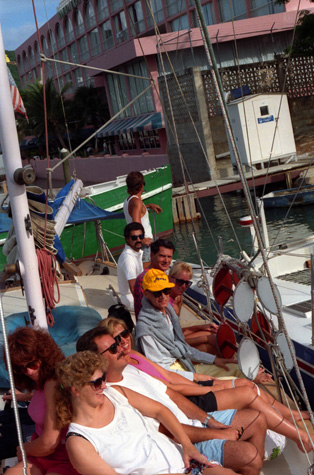 Passengers on Our Sailboat Excursion (Grant, Patty, and Don at Far End) |
(Picture at left) Beyond our group are the Riviera's Assistant Cruise Director, and the a ship's mate (provided by the sailboat concessionaire). This excursion will be about three hours on this sailboat, out of the harbor and down the coast of St. Thomas to an area known for its good snorkeling. The dock from which the sailboat left was just at the end of the berth being occupied by the Costa Riviera.
(Picture at right)
|
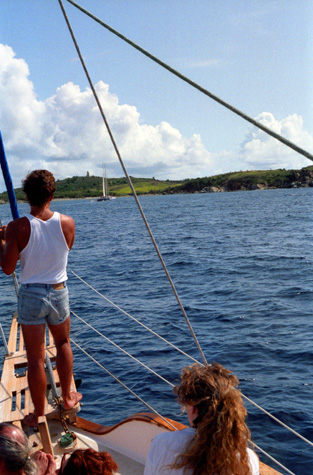 The Coastline of St. Thomas (West of Charlotte Amalie) |
The weather, although warm, was not oppressive. The guy in the tank top is the ship's mate, not the captain of the sailboat. I imagine it is something of an idyllic life, just waiting for cruise ships to dock and then taking their passengers for a sail. The excursion cost about $20 per person, so this three-hour cruise would net the sailboat's owner $200, with minimal outlay for ice and beverages. If you can do this four or five times a week, which should be easy, that is a pretty good salary each year.
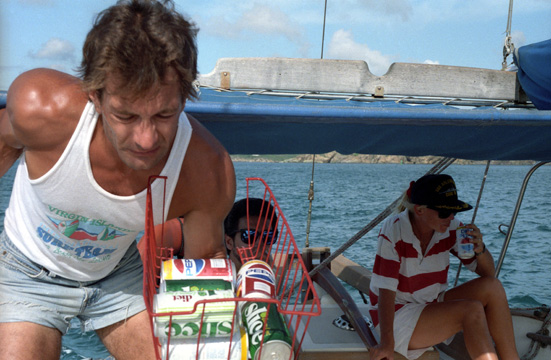 On Our Excursion Sailboat I was actually intending to take a picture of the captain of the sailboat (the girl in the blue hat) and Carlos, but just at the moment I clicked the shutter, the mate came up out of the hatch to the cabin below. |
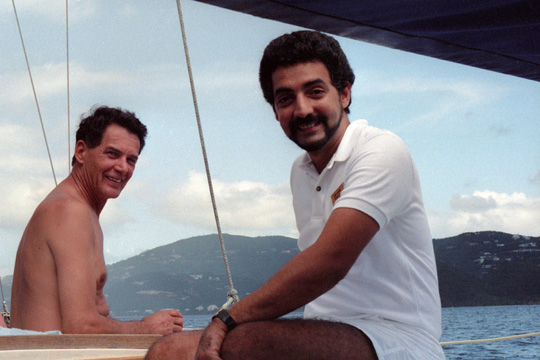 Don and Carlos, the Costa Riviera Cruise Director Carlos seemed like a pretty nice guy; he was on this excursion to see what it was like so that he could answer passenger's questions about it from first-hand experience. |
Grant and I talked to him about his job aboard the cruise ship. He is from Spain (although being from Dallas I am used to everyone who looks Spanish actually being Mexican), and has the fine features of people from Europe, rather than the heavier features of North American Hispanics. We have come quite a good way from the harbor, now, and are getting ready to anchor so that we can go snorkeling.
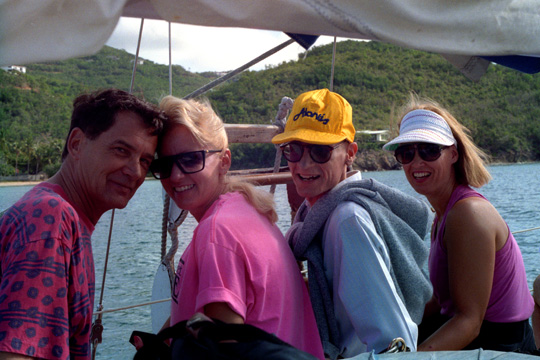 Don, Patty, Grant, and Lynn Aboard the Snorkeling sailboat We are coming in closer to the shore, now, so that we can anchor and break out the snorkeling gear. Everybody looks like they are having a good time, and it was a pretty good day for Grant, too. Lynn was taking good care of him when I was wandering about the sailboat either taking pictures or getting some sun. |
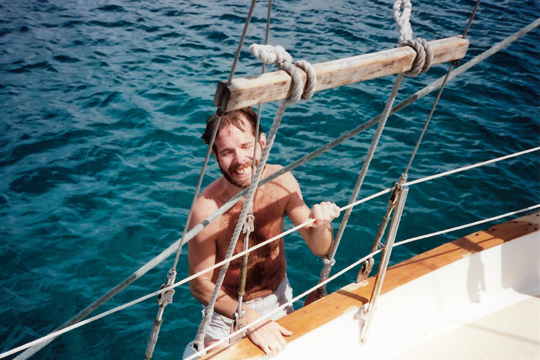 Me Coming Aboard the Sailboat After Snorkeling After I had my fill of swimming around, I returned to the sailboat and Lynn, who had been keeping Grant company, went off herself. Grant and I sat and talked for a while until a few people came back, and then I took another turn in the water. |
Lynn has turned out to be one of the nicest, most understanding people I have ever met. I suspect that she has friends who are in Grant's condition; she seems the open-minded, youthful type for whom having some gay friends is no big deal. Her mother, too, seems quite open-minded and non-judgemental. All of us were doing our best to help Grant enjoy the day. Once we were anchored, we were given snorkels and fins and left to our own after a bit of instruction. After making sure that Grant would be OK, I jumped overboard and went off to see the reef and the fish. It was very interesting, although I could have used more practice at keeping water from getting in my mask. I swam all the way into the shore, but of course did not have my camera so that I could take a picture of the sailboat. Patty and Don were swimming around also, as well as most of the other people on the sailboat.
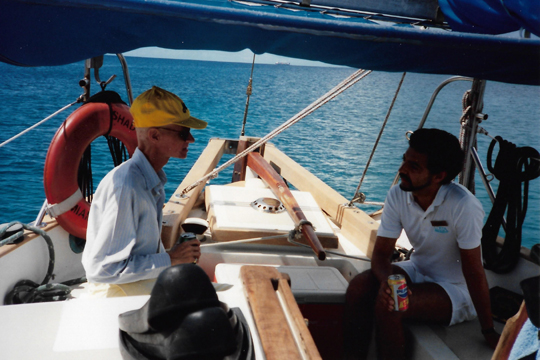 Grant and Carlos Talking on Our ExcursionTitle While I was in the water again, Grant had a chance to talk about what's involved with organizing shipboard activities with the assistant cruise director. Everyone seemed to know without asking what was wrong with Grant; all the shipboard personnel were very nice to us. |
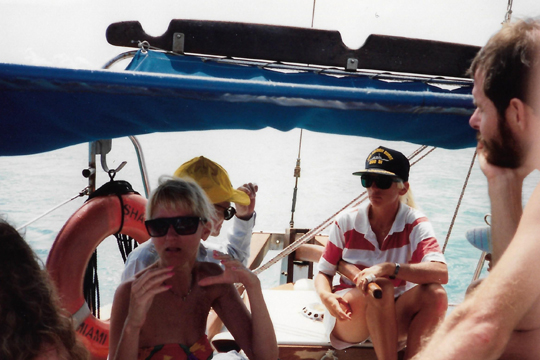 On Board the Excursion Sailboat You can see Patty, Grant, the sailboat captain and me. The mate provided some more sodas and munchies for everyone. Once we were all back aboard from snorkeling, the sailboat headed back to the harbor. |
|
The sail back was very pleasant, and Grant seemed to be enjoying himself. He hung back to ask the captain some questions about her boat, as he always likes to do, and some questions about living in St. Thomas. I know that if Grant could have chosen a future for himself, he would have chosen to be the captain of his own vessel, living in just such a place as this, doing just what this girl was doing. Were it not for the reality of his illness, that might still have been his dream.
The sailboat came back in to its dock in the marina to the northwest of the bow of the Costa Marina. Grant and I had a chance to look at some of the other craft in the marina as Don and Patty headed back to the ship. Then Grant and I headed back as well.
|
We all decided to get some lunch, rest for a bit, and then go shopping at the stores right by the dock. So Grant and I went back to the room to wash up, and then met Patty and Don in the La Dolce Vita cafe where we ate from the buffet. Then the four of us left the ship and walked down the pier to the shopping area.
|
Yes, I saw some things that I thought were relatively cheap, but I have no idea what they would cost at home. Basically, if you see something you like and you think the price is a fair one, you can't get "taken." It's when you try to make a killing on something you don't really want and then find out later that the price wasn't all that great that you feel you got taken. We all bought something, but Patty bought a few things.
It was interesting just wandering through the shops with Grant and Patty. Don had a limited endurance for this sort of thing, and he was about to go back to the ship when I asked him if he wanted to accompany me on my visit to a local Baskin-Robbins store. While our group were shopping, I had inquired as to the location of the two Baskin-Robbins stores I knew to be on the island.
One of them, as it turned out, was just up the street from where the boats docked, and Don and I walked up the street to that store while Patty and Grant continued to stroll through the shops. The store was in a little shopping center only three blocks away, and so I was able to add that one to my list.
My Visit to Charlotte Amalie
|
I went back to our stateroom where I found that Grant had gotten back just a few minutes before I did. I asked him if he would be OK for a couple of hours while I went out exploring, and he said that he would. So, promising that I would be back well before the ship sailed, I left the ship again to head off to Charlotte Amalie.
I could have walked to downtown, but I thought that would take too much time, so I decided to take a local transit bus. Before walking over to the bus stop, I saw that I would have to walk right by the marina we'd sailed from earlier, and it was just then that I realized that I had left a shirt of mine aboard the sailboat this morning, so I stopped by the marina to check for it. The boat was there, but there was nobody around, so I chalked the shirt up to being lost.
I walked over to the bus stop, waited a few minutes for the next transit bus to appear, and then took it downtown. I got off right in the middle of downtown on Veterans Boulevard, the main drag that borders the harbor. Just after I got off the bus, I took this picture of the downtown area. The Baskin-Robbins store is down that alley between the two buildings at left. I had a scoop of pralines and cream, as I recall, and I also recall that the ice cream tasted a bit different than usual, perhaps due to the fact that this store is so far from the main factory. Perhaps the ice cream is made locally. Then I left the store and went back out to the waterfront to enjoy the afternoon.
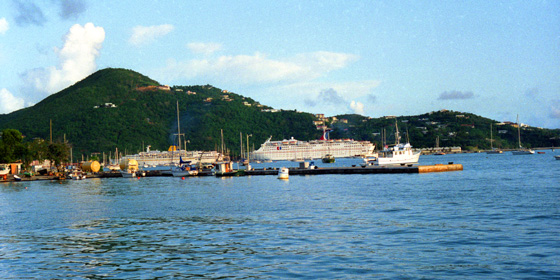 The Costa Riviera (left) and Second Cruise Ship at Our Dock The downtown area is on the other side of the harbor from the dock, beyond the marina you saw earlier. Since I didn't know what the bus schedules were, and I didn't have that much time before the ship was due to sail, I started walking back to the ship. I estimate that the walk was between one and two miles, not far at all. It was about six in the evening, and the ship sailed at seven. |
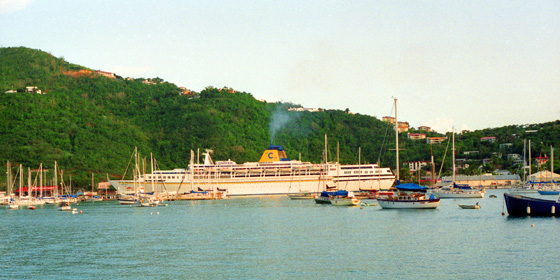 The Costa Riviera Docked at St. Thomas, USVI After I had gone about halfway back, I heard a ship's horn, and saw that there was steam coming out of the funnel on the Costa Riviera, although I still had about 45 minutes before sailing time. Even so, this made me a bit nervous, so I picked up my pace. This is a nice picture contrasting the small (40 foot) sailboats and the huge (700 foot) cruise ship, and the water and the gentle hills. |
On the way back to the ship, what I thought was a pretty amazing coincidence occurred. As I was walking along the street, some traffic came to a stop for a light ahead of me. I looked in the jeep that had pulled up right beside me, and there, to my surprise, was the mate from the sailboat and another person. I called to him and he recognized me from that morning and, lo and behold, he had my shirt. He said he had just been on his way to drop it off at the ship, but I was happy to take it right then. I thanked him and continued walking back to the ship.
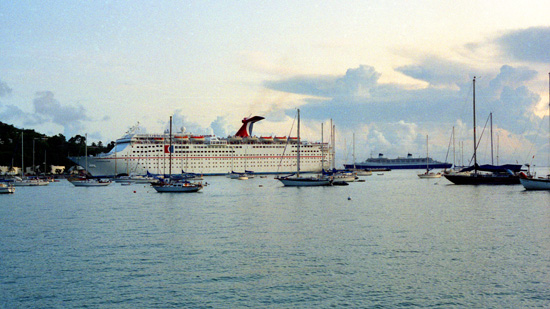 The Celebrity Cruises Ship Docked Behind Us As it turned out, the horn was sounded by this ship, which was beginning to back out as I took this picture. The Norway has turned and is apparently also heading back out to sea. We had just had a nice sunset, the remnants of which make the picture a nice one. |
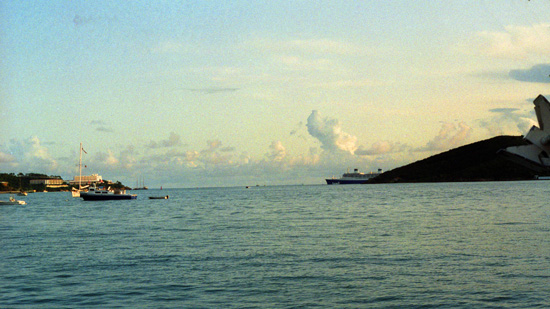 The Norway Leaving St. Thomas, USVI I am a bit closer to the ship now, and perfectly sure that I will be back in plenty of time for sailing. When I got there, the gangway was still open, and there were passengers and crew milling about with about a half-hour before sailing. |
I stayed on the dock until just before sailing. As often happens in the evening on islands like this, the clouds are forming as moisture descends from the hilltops and moves out to sea for the night. The same thing happens regularly in Hawaii.
|
I reboarded the Costa Riviera just a few minutes before our scheduled sailing time, and then make my one big mistake of the cruise.
Although I came back on board, I didn't go right back to the cabin. Instead, I walked around the ship for a bit, watching them untie the lines and cast off. Only when we were out in the harbor did I go back to the cabin to change for dinner. Grant was not there, so I showered and then went up to the Lido deck to find everybody.
Well, when I found Grant he was very mad at me. He thought that since he hadn't seen me that I had missed the boat. He said that I should have immediately come to the cabin to assure him that I was on board, and then gone off to watch the sailing, and I have to admit that he was probably right. Anyway, he stayed mad at me until part way through dinner, when I finally broke down his resistance and he accepted my apology.
This kind of behavior is very unlike Grant, and I assumed that partially to blame was the fact that he was probably not feeling very well at that time and, sure enough, he had some trouble at dinner and had to excuse himself once or twice. I went with him to the head to make sure he was OK, and also to protect his privacy a bit.
Dinner Aboard the Costa Riviera
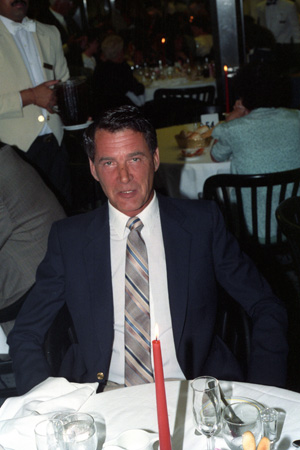 Don at Dinner This was "Tropical Night"- a number of seafood entrees with tropical vegetables and fruits. The dress was casual, but Don decided to dress anyway. So did Patty. |
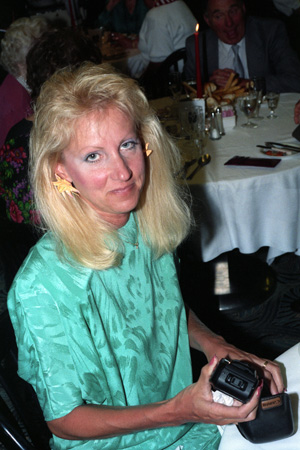 Patty at Dinner Patty brought her own camera to dinner, but I never got copies of her pictures. She is getting over her cold. |
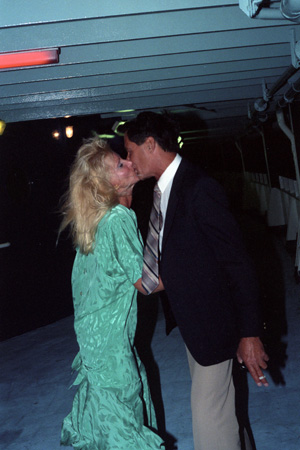 Don and Patty on Deck The two of them seemed to be having a wonderful time, and Grant and I were wondering when they would get married. |
The main dining room was on the same level as our stateroom, but there is no passage through the center of the ship on this level. There are only a few staterooms forward of the dining room, and you have to go up a staircase forward, back through the concession area, past the card rooms and through the Lounge, and then down another staircase to the dining room. I suppose there is a way aft on our level, but it is probably closed to all but crew. This didn't cause Grant much of a problem because there is always the elevator at both ends if he needs it.
We had a nice dinner, and again went up to the lounge for a bit. I took Grant back to the cabin where we spent some time together, and then I went back up on deck for a while to see what was going on in the casino and to go to the midnight buffet. I really wasn't hungry at these midnight buffets, but I went most times just to see what they had and maybe get a piece of dessert, as is my usual habit before I go to bed. Then I turned in. The ship was sailing to San Juan, which is only 75 miles from St. Thomas, so I imagine it does some tacking around during the evening so we can arrive in port in the morning.
You can use the links below to continue to another photo album page for our cruise or to return to the cruise index page to continue on through the photo album.
 |
October 23, 1991: A Day in San Juan, Puerto Rico |
 |
October 21, 1991: A Day at Sea on the Costa Riviera |
 |
Return to the Caribbean Cruise Index |